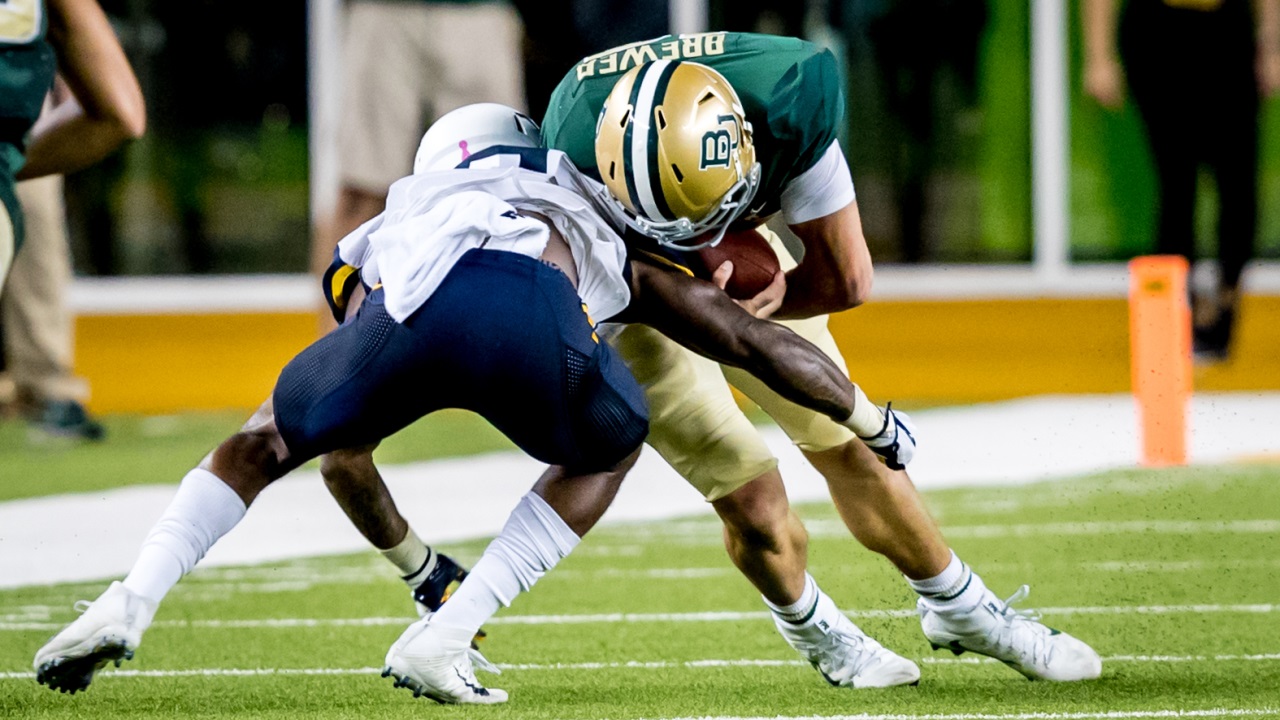
Does the Big 12 play defense? A closer look prior to 2018
Across the country the Big 12 doesn't have the best reputation for defense. Some years it is deserved, some it isn't. How did each team perform in 2017 and what can we anticipate for 2018? Below we will dive into a couple metrics that I tend to look at with each school.
Yards Per Drive
Yards is an old reliable statistic for many but total yards can be biased based on how many plays or drives a team runs. Similarly yards per play can bias towards teams with wide open offensive schemes and punish teams like Air Force that rarely struggle to move the ball per-drive but rarely break really long plays. So how did each team do?
I have two ways of answering that. First I have the average of their YPD from each P5 game compared against "par" which is also known as what the other eight or more P5 offenses averaged against those defenses. Not all opposing schedules challenge an offense as much as others. This tells you how a team did relative to it's schedule. P5 opponents are used so that at least a handful of solid offenses and defenses provide a reasonable comparison number.
I also have the background shaded red, yellow and green. Yellow starts roughly what a median national figure and an average national figure end up being 31ish yards per drive. From there it's plus or minus five yards. Assuming a 12-possession game you would have a total yardage swing of at least 60 yards if you fall outside this. Green is better than five from typical, red is worst than five from there. This tells you if their YPD is good, mediocre, or bad as a stand alone statistic.
The gray bars are each team's "par" while the colored bars are each team. Here is how each defense performed against all their P5 opponents last fall.
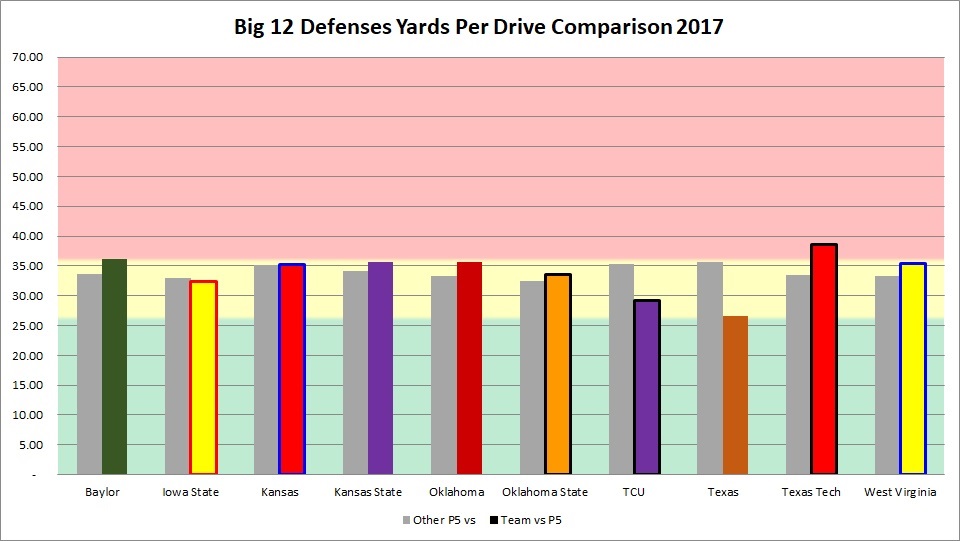
The two defenses that seperated themselves were clearly Texas and TCU. Both we well below 31 YPD and well under "par". The next best was ISU who wasn't much under par but allowed the third fewest raw YPD. The worst raw YPD was easily Texas Tech with 38.55, over 2 yards worse than the next worst number. However this includes a bad outing vs Arizona State and their common opponent comparisons against most of the league are much easier on the eyes.
The following chart shows last year compared to the 2016 season.

When we compare each team to 2016 we see massive improvement by Iowa State, Texas and Texas Tech. We also see a regression by WVU, OU, OSU and KU. KSU, TCU and Baylor were mostly what they were relative to par. Tech's improvement was illustrative as they cut their margin versus par in half but still were on the wrong end of it. West Virginia and Oklahoma struggled against a group of P5 teams that averaged fewer yards against other opponents than their 2016 foes.
Red Zone Points
Yards tell part of the story, but even if you give up yards you can prevent giving up points if your red zone defense is stout. Here's how many points each team gave up per red zone attempt. Any offensive touchdown is worth 7 points (it would round to that even if I tracked PAT and 2 point attempts) and any made field goal is 3. The yellow band in this chart represents what the middle 33 percent of the country's offenses averaged in points per red zone attempt.
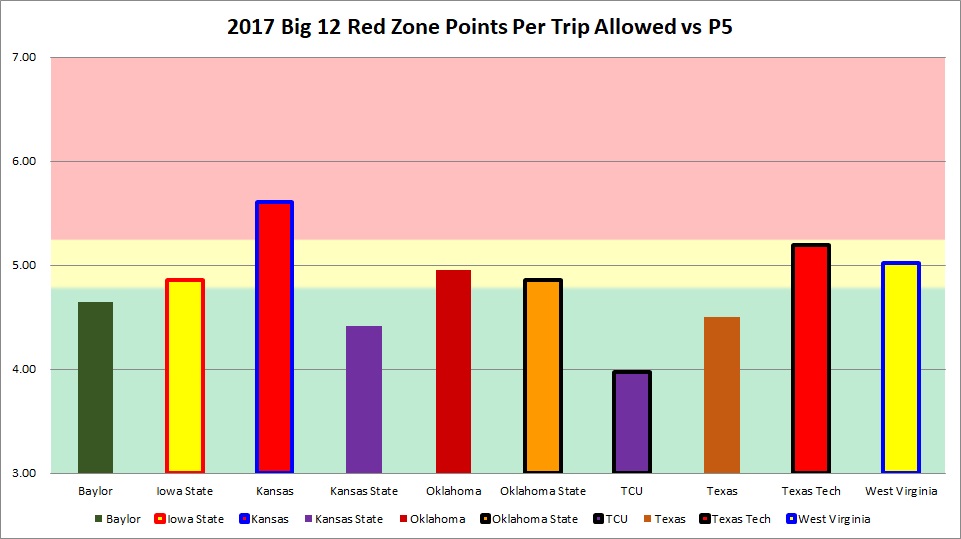
The best red zone defense was played in Fort Worth but it's clear that even with G5 and FCS foes omitted that the Big 12 gets stingier inside the 20. TCU, Texas, KSU and Baylor all score in the green here with ISU, OSU, and to a lesser extent OU just outside of it. The worst isn't even close as it's KU by a mile. Ironically, KU was better than six other conference members in pure yards per drive defense against common opponents but allowing such high points per red zone trip essentially squandered it. KSU was practically the opposite, barely holding on to fifth in common opponent yards per drive without much of a gap with the back half of the league but second best in red zone points. WVU and Tech were below the national midpoint but not bad.
Explosive Plays
Living to fight another down is huge in this sport and teams who can pair good red zone defense with denying the big play can seem to punch above their weight. This chart and the prior chart shows a good portion of why ISU was so much better defensively; they denied both big plays and red zone points well. ISU is dramatically below both the league average and national median figures. Texas Tech also performs well here which mitigates some of the damage from lower tier yards per drive and points per red zone trip performances. Baylor shows up very poorly here but as discussed in last week's premium article they outperformed the national median over the final four games of the year which shows dramatic improvement.
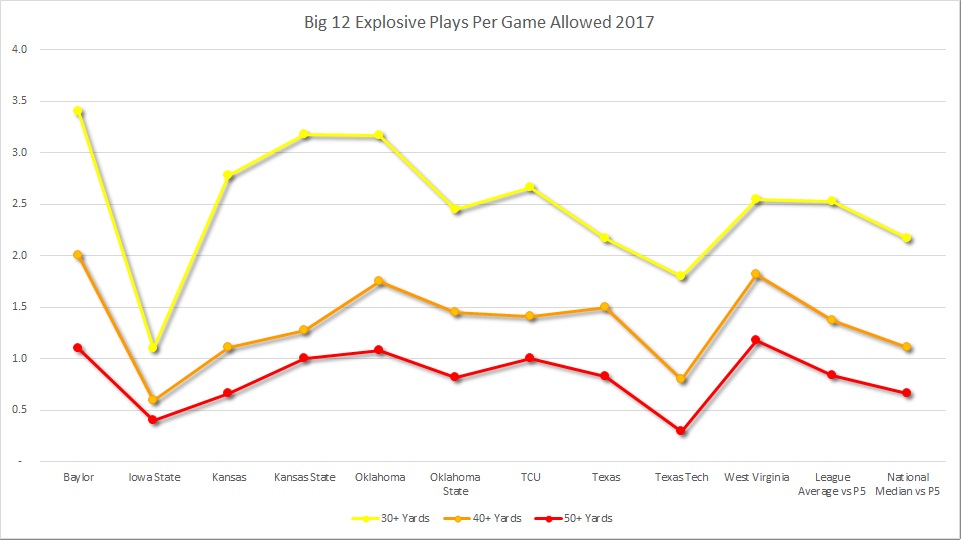
Who was the best in YPD against common opponents?
Texas and TCU were the clear one and two in yards per drive. The Frogs were better in the red zone but unless your team is from Kansas the Longhorns held you to lower yardage.

TCU, however, held a reasonable lead on the third ranked ISU Cyclones in common opponent yards per drive with a few games of a lead and a few neck and neck.
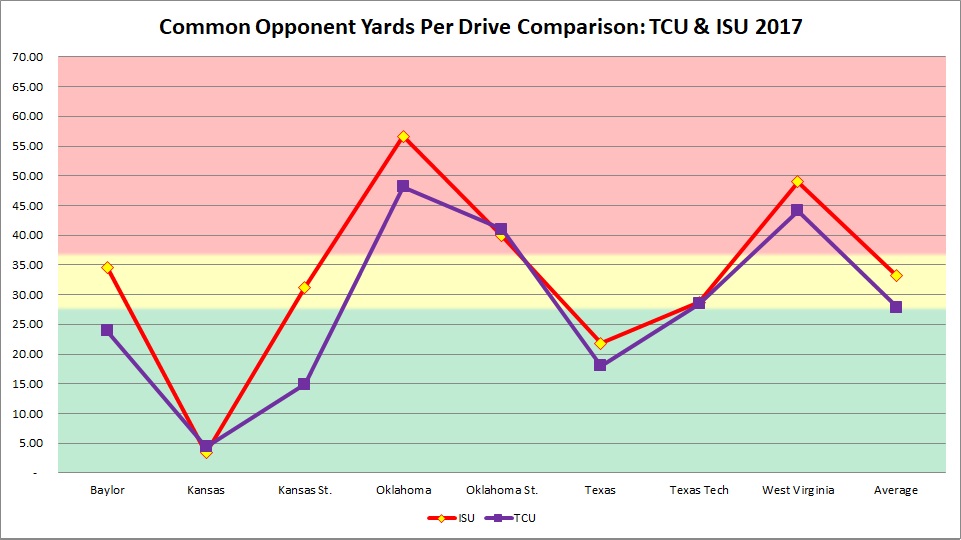
The Comparisons that Surprised Me
The comparison I could believe but was surprising was Kansas ranking fourth in common opponent yards per drive as KU had been reasonably decent versus par in 2016 and returned three or four really standout defenders. Their red zone defense along with the worst Big 12 offense made it a moot point though.
The big shock was the team ranking last in common opponent yards per drive... Oklahoma.

It's no secret that defensive coordinator Mike Stoops isn't the darling child of OU's fanbase after last season. This is a large reason why that's the case. Oklahoma, one of the top five winningest programs of all time that recruits better than all but maybe one team in the league was 10th out of 10 in yards per drive defense against common opponents. I never expected to see that and it's a testament to arguably the most insanely productive offense in OU's history that they were a playoff team last year.
So How Did It Translate to Points?
Offensive points per drive is one metric I have sometimes avoided unless I could filter out "gimme points" on short drives and non-offensive points as I see those two sources as less than indicative of an offense or defense and more indicative of a team statistic. With that said I do think a look here can illustrate how things tie together and I was able to omit direct non-offensive scores leaving only short fields to skew things.
We see Texas and TCU who scored strongly in all metrics leading the pack but ISU. who wasn't overwhelmingly successful in yards per drive or red zone points, was able to leverage those showings and a very strong showing in explosive plays to dramatically limit how many offensive points they surrendered. We also see explosive plays tank Baylor's showing which was solid in the red zone and comparable to at least four other teams in yards per drive. It also shows how much explosive plays made the difference for OSU and ISU who had relatively similar yardage and red zone figures against common opposition.

Looking to 2018...
- The biggest task for Baylor will be limiting big plays. The red zone defense was respectable and the yardage, while not good, was not far off of the middle of the league. Baylor's common opponent YPD and red zone points were not far from Oklahoma State which was arguably the fourth best unit in the league. However, explosive plays were not equal and it made a big difference.
- Texas and TCU project well as they should do well enough to reload what they lost with proven defensive coaching under Todd Orlando and Gary Patterson. That's a good thing for each as both have serious questions on offense despite some young players with recruiting hype and upside which I will dive into in the offensive article.
- Iowa State should be strong as long as their move to a conservative dime defense doesn't suffer from a counterpunch schematically as that could change the amount of big plays they give up to a large degree. However, until someone does that ISU should be more than a handful for teams as their offense is one of the most underrated in the conference.
- Oklahoma and WVU have a lot of preseason hype but I have huge questions about each as their yardage and explosive play defenses were not good and their red zone figures were middle of the road. WVU has a great offense coming back and OU has the potential to produce big even without Mayfield, Andrews, Flowers, Brown, etc. For either of them to reach the league title game these defenses likely need to improve and there's room to do it across the board.
- Kansas was solid enough in yardage compared to everyone else and while bad in 30-plus yards plays, they limited 40 and 50-plus yard plays. However, all of that was squandered and will be squandered again if they can't stop surrendering red zone touchdowns. Their offense is obviously a bigger issue but for them to post more wins they likely can't surrender 5.6 plus per red zone trip as there's only so much we can expect the offense to improve this fall roster-wise.
- Texas Tech deservedly got some small respect for their defensive improvement after a terrible 2015 and 2016. They still have a ways to go but if they can make the kind of jump they did from 2016 to 2017 this fall we could see Tech challenge for a league title game appearance even if their offense isn't the best they've seen. However, that improvement needs to continue because as much as Tech improved their common opponent stats in YPD and Red Zone, points are almost identical to a Baylor defense that must improve. If it doesn't we could see Tech backslide.
- Finally, Oklahoma State is going to be a new animal entirely with the gambling scheme that Baylor saw in Durham last fall against Duke. Ultimately, don't be surprised if they eventually do what TCU does where they'll take calculated risks but end up pretty strong on yards and points while not necessarily excelling on big plays per game relative to league and national standards. It's a profile that also fits with the Virginia Tech Hokies under Bud Foster. That could play well for them if the new parts of the offense can continue to put up points.
We'll cover the league's offenses in Part 2.
